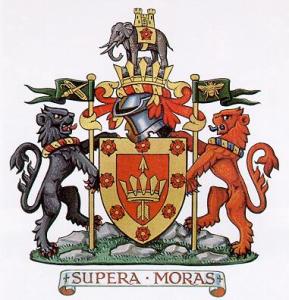Elephants; we associate these large and trunky mammals with Asia and Africa where the majority of them probably reside. It’s well known that they’re heavy and tall (male African elephants can reach 7000kg and 13ft), have tusks that have been poached for many years and long, grey trunks. Their massive ears are actually help to control their temperature, though we may make jokes about the size of them. Dumbo is probably one of the most famous fictional elephants, along with Nelly, who provided many children with lots of enjoyment over the many years that the two of them have been around.
So what are they doing in the town of Bolton, England?
The relationship between Bolton and the elephant has lasted for over two hundred years. The first recorded usage of the elephant was in 1799 on the official stamp of the Clerk of the Board of Trustees.
The elephant itself is a very significant part of the Bolton coat of arms; the elephant sits on top of a crown, the Lancashire red rose draped over its body and a castle resting on top of its back. Though the emblem also features two lions, it’s the elephant which has stolen the hearts of the Bolton people for centuries.
Wherever you look in Bolton, you are bound to find at least one representation of the animal. The coat of arms is displayed all over the town centre, on various buildings, including the market and the old market hall. They included our faithful friend on the war memorial, his tusks on the railing of the museum and little stone elephants on top of the market’s bollards. Many of these features are old, so old that it makes you wonder whether Bolton still cares about this important part of its heritage.
But if you look closely enough, there are also examples of where the elephant is used in more modern decoration. The town hall square is blocked off on several sides with new bollards – each of which is printed with a beautiful, blue coat of arms. There you will find the elephant in all its glory.
Many years ago there were stone elephants on one side of town; they were popular amongst residents and probably tourists, also. Most children in the town will probably have had a go at sitting on one of the elephants at some point in their life. In 2006 it was reported that the stone elephants, which had been there for 25 years, were to be removed. Vandalism had meant that they had become damaged; one of them had even been so irreparable that it was removed. A year later and the grey elephants were replaced with a new herd, three beautiful, colourful elephants which gave new life to the idea of elephant sculptures in the town. The newer elephants are still there today, immortalising designs created by children who are now well on their way to adulthood, a plaque standing at the foot of each with the name given to the elephants. They are a true representation of the town’s love of this mammal.
The introduction of the new elephants (which cost £30,000) was also the introduction of a new elephant trail around the town, an opportunity for residents and tourists alike to travel the streets of Bolton in search of the many elephants on offer. Unfortunately, any sign of that trail has disappeared, but the elephants still stand.
When I took a trail of my own, venturing through streets where I knew elephants were located, I was pleasantly surprised by the number of elephants I found. Having lived there for 26 years, spending some happy childhood memories sitting on the grey stone elephants before they were removed, it was amazing that I had never taken a trip to visit the elephants.
Now when I visit the town I will notice the elephants sitting in their place, remembering that they have been a part of my life for a long time. They say that when something is right under your nose you don’t really see it anymore, and they’re right. I barely walk around my town thinking about the history of buildings, or looking at the dates when they were built. But my trip around the elephant trail showed me just how beautiful some of the buildings are, when you look close enough. I don’t think I’ll ever see the town in the same way again.
Here are the rest of the elephant photographs I took on my journey:

